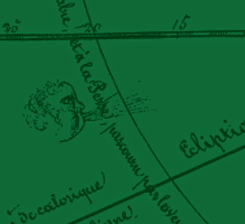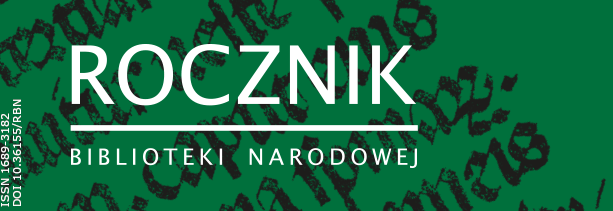NUMERY ARCHIWALNE

STRONA REDAKCYJNA, SPIS TREŚCI, s. 1–8 / CREDITS, TABLE OF CONTENTS, 1–8
STUDIA I MATERIAŁY / STUDIES AND MATERIALS
Proces transformacji JHP KABA na Deskryptory Biblioteki Narodowej – wprowadzenie, s. 11–12 / Process of transformation of JHP KABA into Descriptors of the National Library: an introduction, p. 11–12
The paper is an introduction to the description of the transformation process of KABA subject headings system (JHP KABA) into Descriptors of the National Library of Poland (DBN) with the use of a selected part of JHP KABA vocabulary as an example.
Transformacja określników formy JHP KABA na Deskryptory Biblioteki Narodowej, s. 13–22 / Transformation of JHP KABA form determiners into Descriptors of the National Library of Poland, p. 13–22
The article contains reflections on the transformation of JHP KABA determiners into Descriptors of the National Library of Poland (DBN). The author presents the results of research on comparing lexical units in JHP KABA and DBN. She draws conclusions from her own work which consists in mapping form determiners in JHP KABA with DBNs. The author chooses examples that are representative for particular groups of determiners and presents possible solutions provided that there may be more than one. The transformation of elements expressed in JHP KABA form determiners is a complex process, and not all of the determiners can be included in DBNs. In order to prevent information loss, solutions need to be used that improve the searching process without causing information chaos. After the transformation, some of the information carried by form determiners, will appear in the bibliographic record fields that are used for other categories. Consequently, not everything that was coded as form in JHP KABA will remain so after the transformation.
Transformacja tematów formalnych JHP KABA na Deskryptory Biblioteki Narodowej s. 23–30 / Transformation of JHP KABA formal subjects determiners into Descriptors of the National Library of Poland, p. 23–30
The present paper concerns the transformation of JHP KABA formal subjects determiners into Descriptors of the National Library of Poland. The study is based on data from the National Central Universal Catalogue (NUKAT). The transformation presumes no loss in subject characteristics in bibliographical records and gives the possibility of searching the catalogue with facets. The authors believe that for library users DBNs will be an enhanced searching tool that does not require the use of complex queries.
Czytanie książek – ujęcie jakościowe, s. 31–64 / Book reading: a qualitative study, p. 31–64
The article presents the aims, methods and main results of a qualitative study of readership performed by the National Library of Poland in July 2015. The project in question aimed at supplementing the results of the survey research on readership carried out by the Library with information about readers’ family and school experiences related to books, the role of reading books in different lifestyles and among other practices of developing one’s knowledge. Consequently, the author analyzes the results of the research in the context of surveys carried out throughout Poland since the 1970s. The research used the focus group interview method in ten groups of people differing in gender, age, education background and attitude towards books. Its main results indicate changes in both reading habits and in ways of understanding terms such as “book” and “reading books”. The article discusses these changes, as well as their implications for quantitative studies and reading popularization.
Książki bardziej książkowe od innych. Społeczne atrybuty prototypu książki, s. 65–100 / Books more booklike than the others. Social attributes of a book prototype, p. 65–100
In surveys on reading, respondents are usually asked about the number of books they have read over a given period, assuming that the meaning of the term “book” is unambiguous. This article presents the results of an experiment in which Eleanor Rosch’s prototype theory was applied to perception of books by non-professionals. Focus group participants were presented with 23 publications differing in genre and function (novel, scientific textbook, album, comic book, poetry, drama), typography and physical form (brochure, paperback, hard cover) and asked to put them in order from most prototypical book to least prototypical one.
Although the groups slightly differed in their classifications, several books were unanimously indicated as prototypical: these were thick novels with a plot that requires linear reading from cover to cover, whose content was created and refined by a professional novelist and whose pages are filled tightly with text. Non-fiction books, which are read “on purpose”, like textbooks, scientific monographs, encyclopedias, as well as albums and comic books, are regarded as less prototypical. Therefore, when answering questions in surveys, respondents may omit some books they actually read but perceive as non-prototypical.Jak poznać Pana Tadeusza? Jakościowe badanie preferencji dla różnych nośników tekstów literackich, s. 101–118 / How to get to know Pan Tadeusz? A qualitative study of readers’ preferences regarding different media for literary texts, p. 101–118
The article discusses social and situational preferences of readers regarding different ways of getting acquainted with literary classics: reading books, printed or in digital form, listening to audiobooks or watching film adaptations. This analysis is an empirical one as it is based on the results of a qualitative study carried in 2015 by the National Library of Poland. It facilitates the understanding of the reasons why people prefer one way of exploring a text to another, and what they believe it the meaning of “getting to know” a literary text. The results of the study in question allow the hypothesis that the choice between paper and digital text media depends mainly on practical and situational factors. They also show that familiarity with book culture influences the way a text is understood: as an invariable intent of the author or as the outcome of an interpretation process that can also be shaped by the reader himself.
Potoczne definicje wiarygodnej informacji, ciekawej opowieści i mądrości, s. 119–152 / Common definitions of reliable information, interesting story, and wisdom, p. 119–152
The main question discussed in the article concerns the role of books in searching for information and in the assessment of its value. The authors analyze the results of a qualitative study performed in 2015 by the National Library in Poland. They aim at reconstructing common definitions of information, interesting story and wisdom and at determining the role of books in these definitions. The results of the study show many similarities in the methods of searching for information in people who read books on a regular basis and in those who read hardly any. This is evidence for the fact that literature still remains an important source of narratives and of wisdom. This relationship was indicated by both readers and non-readers. In common definitions of an interesting story and of wisdom, the most significant differences between the respondents were related to their gender and degree of education rather than to their reading habits.
Przyjemności z wyboru czytania, s. 153–186 / Reading for pleasure, p. 153–186
The article is based on the analyses of 10 group focus group interviews performed within the scope of a qualitative study “Common definitions of book”. The study involved people from different social groups, at different life stages and having different ways of participating in reading culture. The analyses of the interviewees’ responses have provided answers to the following research questions:
– What is the place of reading books among people’s favorite leisure activities after they have done their job?
– To what extent and under what circumstances reading books is an alternative to other pastimes and what are the conditions for the interviewees to take it into account?
Based on the analyses of the interviews, it can be concluded that the most important reason behind the choice of a book is pleasure. The analyses presented indicate social dimensions of the sources and apability of being satisfied with reading a book.Socjalizacja do czytania – edukacja szkolna i kręgi rówieśnicze, s. 187–216 / Socialization to reading, p. 187–216
One of the objectives of the study „Common definitions of book” was to investigate the perception of reading books in different social environments, also those where, as shown by surveys, aversion to read becomes stronger and stronger. It raises the question how the transmission of cultural models of reading is reflected in the experience and awareness of people from various social environments and with different reader’s biographies. The article presents the results of the analyses of focus group interviews that allow us to determine the place of reading books in relationships between peers and to see whether reading is becoming important or attractive to the youth and whether it unites them or divides. Another aspect of the abovementioned analyses concerns the impact of how Polish literature is taught at school on readers’ attitude and why it is so.
Teraźniejszość i przyszłość bibliotek. Co wyobrażenia dotyczące przyszłości mówią o współczesnych bibliotekach oraz ich potencjalnych użytkownikach?, s. 217–240 / The present and future of libraries. What can our visions of the future tell us about present-day libraries and their possible users?, p. 217–240
Focus group interviewees were asked to imagine what a public library would look like in the next twenty or forty years. Discussions on the future of public libraries triggered spontaneous feedback on the current shape and functioning of public libraries. Library users are satisfied with libraries they currently attend and want them to remain unchanged. In addition to borrowing books, they value librarians’ efforts to complete and update their book collections and welcome improvements, such as automatic reminders or a phone-call from a librarian that prevent them from being fined for overkept books. Students appreciate libraries as a place to study in the presence of other readers and to meet with colleagues to collaborate on joint projects. They prefer direct bookshelf access enabling serendipity in their queries to using electronic catalogues. Middle-aged women from small towns enjoy events held by local library as an opportunity to go out and meet with friends. People who do not use public libraries believe that most data and books can be found on the Internet without leaving home. They say they are afraid of having to pay library fines and to wait in line for attractive new publications popular with other readers. They regard using libraries as costly because of the time they have to spend to get there and the physical distance they have to cover. While fantasizing about libraries of the future, they imagine them being similar to ATMs or parcel machines which make books available to readers with no librarians involved.
Scenariusz wywiadu, s. 241–251 / Scenario of an interview, p. 241–251
Scenario of an interview
RECENZJE I SPRAWOZDANIA / REVIEWS AND REPORTS
Katalog inkunabułów Książnicy Pomorskiej w Szczecinie, opracowały Agata Michalska i Alicja Łojko, Szczecin 2016, s. 255–262 / Review of: Katalog inkunabułów Książnicy Pomorskiej w Szczecinie, opracowały Agata Michalska i Alicja Łojko, Szczecin 2016, p. 255–262
Jakub M. Łubocki, Okładka jako część dokumentu na przykładzie płyty gramofonowej w ujęciu bibliologicznym, Warszawa 2017, s. 263–277 / Review of: Jakub M. Łubocki, Okładka jako część dokumentu na przykładzie płyty gramofonowej w ujęciu bibliologicznym, Warszawa 2017, p. 263–277

